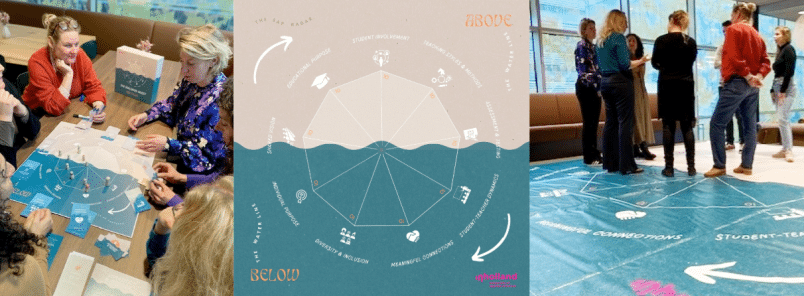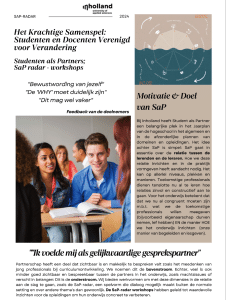The Students as Partners (SaP) method
Systemic co-design principles can be applied in educational institutions to improve the condition of “the system”. The SaP method, developed by the research group Authentic Leadership at Inholland University of Applied Sciences, consists of various instruments. The method creates dialogue and engagement between students, teachers, other education professionals and the professional field by promoting well-being and cultivating real relationships. This makes the method very suitable for teachers, students, researchers, staff in HBO, MBO and universities.
The SAP Radar and Systemic Co-Design
The idea behind SaP is simple: SaP is essentially about the relationship between learners and teachers. How we organize this relationship and shape it in practice, at different levels, in different places and ways, needs attention. After all, future professionals need to learn how to meaningfully and constructively enter into relationships. In the educational field, this means that we must be congruent with regard to what we want to pass on to future professionals (for example daring to take ownership, having courage) and HOW we organize education (our way of guiding and teaching).
Partnership has a part that is visible and easy to discuss, such as the participation of young professionals in curriculum development. We call this the upper current. However, much is also less visible and negotiable between the partners in education, such as power issues or differences in interests: this is the undercurrent. We offer working methods to work with these dimensions in the relationship, such as the SaP radar, a game that enables dialogue about other themes than usual and outside the normal setting.
The SaP method not only promotes dialogue, but also encourages active involvement of all stakeholders in redesigning education. By jointly exploring power issues, different interests and other underlying dynamics, SaP contributes to creating inclusive, collaborative processes that are essential for Systemic Co-Design.
How to use the SaP-Radar
The SaP Radar enables a conversation about themes that are otherwise rarely discussed. This also opens the dialogue about ‘what could be’. A conversation about partnership and what desirable relationships are.
A SaP radar Game, Mega Canvas and an Online tool have been developed as interactive instruments. These are intended to promote conversations, provide insight into dimensions that are important to the group and enable targeted improvements in education.
– SaP Radar Game (English): “The Dialogue Quest”: Uncover the Unseen, Speak the Unspoken
an interactive game for group discussions and composed action points.
– SaP Radar Mega Canvas
a 5x5m canvas for group discussions and gaining insight into important dimensions.
– SaP Radar Online
an online tool that helps generate quantitative AND qualitative data insights and a offers a more targeted approach to education with larger groups.
The Students as Partners approach, insights and outcomes are described in detail in this document:

